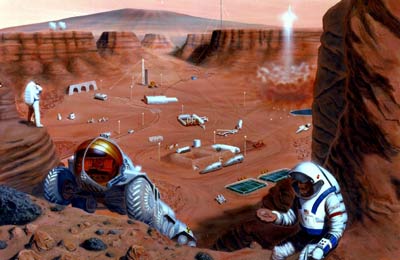Debunking the invalid claims of a space radiation paperby Robert Zubrin
|
| The four-millionfold difference in dose rate between the lab study and spaceflight is of critical importance: the effects of large doses of toxins delivered suddenly is entirely different from the effect of the same amount of toxin delivered in very small amounts over a long period of time. |
In fact, however, the study has no relevance for human Mars exploration, as the irradiation doses inflicted on the researchers’ unfortunate subjects has no relationship to what would be experienced by astronauts on their way to the Red Planet. The principal difference is that the rate that the dose was administered to the mice under study was four million times faster than that what travelers in interplanetary space would experience. In addition, the total cumulative dose delivered to the mice inside of 30 seconds was about 50 percent greater than the GCR dose that astronauts would receive over the course of a 2.5-year Mars mission.
The key numbers in question are as follows: In the mouse experiment, the victims were give a dose of 30 rads (0.3 Gray) at a rate of 100 rads per minute. On a Mars mission, astronauts would receive a dose of 1 rad per month during the six-month outbound and return transfers, and about 0.5 rad per month during 18 months on Mars, for a total of 21 rads. (1 Gray = 100 rads = 100 cGray. For GCR, 1 Gray = 6 Sieverts = 600 rem.) Space dose rates can be found in “The Cosmic Ray Radiation Dose in Interplanetary Space – Present Day and Worst-Case Evaluations,” R.A. Mewaldt et al., 2005.
The four-millionfold difference in dose rate between the lab study and spaceflight is of critical importance. It is a well-known finding of both chemical and radiation toxicology that the effects of large doses of toxins delivered suddenly is entirely different from the effect of the same amount of toxin delivered in very small amounts over a long period of time. The difference is that the body’s self-repair systems cannot deal with a sudden dose, but can easily manage the same dose if received over an extended period. For example, if an individual were to drink one shot of vodka per second for 100 seconds, he would die. But if the same person drank one shot of vodka a month for 100 months, he would experience no ill effects at all. This is about the same ratio of dose rates as that separates the invalid work reported in the paper (1.6 rad per second) from what astronauts would actually experience in space (1 rad per month.)
It is shocking that the authors neglected to caveat the significance of their results by admitting these differences. Not only that, they kept the information about actual dose rates employed buried deep within the paper (it can be found in the middle of a text paragraph towards the end entitled “Animals, heavy ion irradiation, and tissue harvesting”), thereby allowing it to easily be missed by popular science writers duped into reporting the allegedly sensational implications of their irrelevant work.
| The space program costs many billions of dollars spent at a real cost to meeting human needs elsewhere. That fact imposes a moral obligation on the program to move forward as quickly and efficiently as possible. |
It is true that small amounts of toxins received over a long period can statistically increase a person’s risk of ill effects. However, we already have data that shows that the accumulation of slow rates of cosmic ray radiation received during long duration spaceflight is not a showstopper for human Mars exploration. GCR dose rates in low Earth orbit are about half those in interplanetary space. Thus, there is a growing number of cosmonauts and astronauts who have already received Mars mission equivalent GCR doses during extended space missions without any radiological casualties.
Furthermore, the International Space Station (ISS) is continuously occupied. That means that while Mars missions are only in space about 40 percent of their mission time, the total GCR dose (measured in person-rems) that the ISS program crews will receive over the next ten years of planned operations is about the same as would be received by a series of five crews of five people each if they launched to Mars every other year over the same period. The ISS program has, in essence, already accepted the same level of GCR risk for its crews as would be faced by an ongoing human Mars exploration program.
Galactic cosmic radiation is not a showstopper for human Mars exploration, and should not be used as an excuse for delay. The space program costs many billions of dollars spent at a real cost to meeting human needs elsewhere. That fact imposes a moral obligation on the program to move forward as quickly and efficiently as possible. It is understandable that radiation researchers should want to justify their funding. But they should not spread misinformation to promote themselves at such extraordinary expense to the public.
